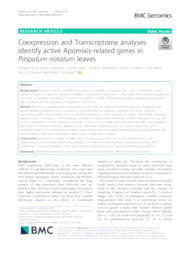Coexpression and transcriptome analyses identify active apomixis-related genes in Paspalum notatum leaves.
Coexpression and transcriptome analyses identify active apomixis-related genes in Paspalum notatum leaves.
Autoria: OLIVEIRA, F. A. de; VIGNA, B. B. Z.; SILVA, C. C. da; FAVERO, A. P.; MATTA, F. de P.; AZEVEDO, A. L. S.; SOUZA, A. P. de
Resumo: Background - Paspalum notatum exhibits both sexual and apomictic cytotypes and, thus, is considered a good model for studies of apomixis because it facilitates comparative approaches. In this work, transcriptome sequencing was used to compare contrasting P. notatum cytotypes to identify differential expression patterns and candidate genes involved in the regulation of expression of this trait. Results - We built a comprehensive transcriptome using leaf and inflorescence from apomictic tetraploids and sexual diploids/tetraploids and a coexpression network based on pairwise correlations between transcript expression profiles. We identified genes exclusively expressed in each cytotype and genes differentially expressed between pairs of cytotypes. Gene Ontology enrichment analyses were performed to better interpret the data. We de novo assembled 114,306 reference transcripts. In total, 536 candidate genes possibly associated with apomixis were detected through statistical analyses of the differential expression data, and several interacting genes potentially linked to the apomixis-controlling region, genes that have already been reported in the literature, and their neighbors were transcriptionally related in the coexpression network. Conclusions - Apomixis is a highly desirable trait in modern agriculture due to the maintenance of the characteristics of the mother plant in the progeny. The reference transcriptome, candidate genes and their coexpression network identified in this work represent rich resources for future grass breeding programs.
Ano de publicação: 2020
Tipo de publicação: Artigo de periódico
Unidade: Embrapa Pecuária Sudeste
Palavras-chave: Apomixis, Differential expression, Gene coexpression network, Paspalum, RNA sequencing
Observações
1 - Por padrão são exibidas publicações dos últimos 20 anos. Para encontrar publicações mais antigas, configure o filtro ano de publicação, colocando o ano a partir do qual você deseja encontrar publicações. O filtro está na coluna da esquerda na busca acima.
2 - Para ler algumas publicações da Embrapa (apenas as que estão em formato ePub), é necessário ter, no celular ou computador, um desses softwares gratuitos. Sistemas Android: Google Play Livros; IOS: iBooks; Windows e Linux: software Calibre.
Acesse outras publicações
Acesse a Base de Dados da Pesquisa Agropecuária (BDPA) para consultar o acervo completo das bibliotecas da Embrapa.

